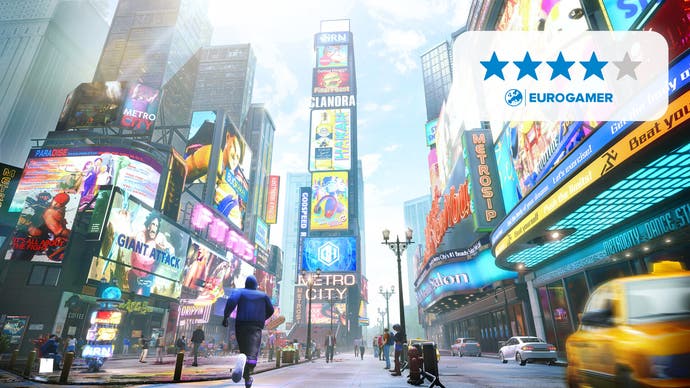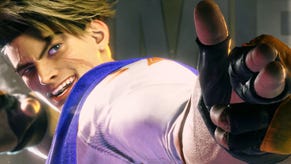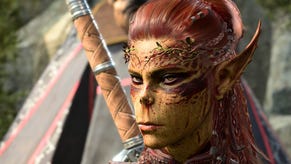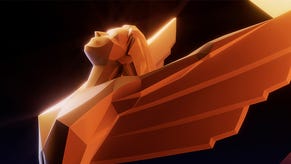Street Fighter 6 review - social, silly, spectacular
Run it back.
Street Fighter 6 feels like a response, the counter-punch from a developer bruised and battered after a heavy defeat. You can't call it a comeback - for the fighting game core Street Fighter 5 served its purpose well enough. But you can call it a triumphant return to the ring; better, wiser and with a new plan of attack.
Street Fighter 5 launched half finished. Online play was a broken mess, the story mode was barebones and there was no arcade mode - a fighting game prerequisite. Street Fighter 6 follows up on that release disaster with a meaty campaign mode unlike anything we've seen in the series, an online hub that recreates the feel of an old-school arcade, and a raft of single-player options to fuss over. All this on top of a world class combat system and fighting feel. It's a fantastic package - perhaps the best Street Fighter's ever had.
From the main menu three pillars present themselves: World Tour, Battle Hub and Fighting Ground. World Tour is a 25-hour ish single-player campaign in which you create an avatar and embark upon an adventure to find out the true meaning of strength. This plays out as a third-person, Yakuza-lite experience, which is something I never thought I'd say about a Street Fighter game. Metro City from Final Fight (Capcom has fused the Street Fighter and Final Fight universes into one) is the initial explorable area. Here, there are characters to talk to, "masters" (Street Fighter characters such as Luke, Chun-Li and Ken) to learn moves from, and quests to complete. There are nooks and crannies to explore (some only found after performing a gravity-defying special move such as E. Honda's flying headbutt), secrets to uncover and side jobs to complete for cash, which you can spend at shops on things like vitality-restoring food, new clothes and gifts. As you play you earn experience and level up. There is a rudimentary skill tree and gear with its own set of stats to equip. You can even switch between day and night time and the world and its NPCs change accordingly.
World Tour, then, is Street Fighter RPG, but it's also completely and utterly silly. You can beat people up - anyone, really, apart from kids - and everyone's well up for it. Metro City's like Fight Club without the secret rules. Walk up to someone and ask for a fight and they'll be like, of course, let's go! Or just Spinning Bird Kick straight into their gut to skip the foreplay. The game then switches into the standard 2D fighting perspective for a round. Win or lose, you switch back to the 3D perspective and get on with your day. No-one bears a grudge. No-one's like, I've had enough of this city and people randomly beating me up, I'm packing up and moving out. No. In Street Fighter 6, fighting is life!
Enemies - mostly gang members who wear cardboard boxes on their heads (it's a whole thing) - chase you down the street if you get too close, itching for a fight. The experience of walking the back alleys of Metro City is a bit like a night out in Croydon: no matter your Dutch courage level, it's best you don't aggro the locals.
Eventually you'll go on a globe-trotting adventure involving crime syndicates, rebel factions and increasingly daft side quests. At one point I found myself tearing posters off walls. There's a side job where you star in a fight scene straight out of a 70s Hong Kong martial arts movie. You can beat up a truck, a fridge and a server stack (the server stacks are rock hard!). I helped a drone pluck up the courage to ask another drone on a date, but not before it (he?) made good on a delivery to a vendor who was waiting for new supplies. Nothing makes sense, everyone's up for a scrap, and Street Fighter 6 is having the time of its life.
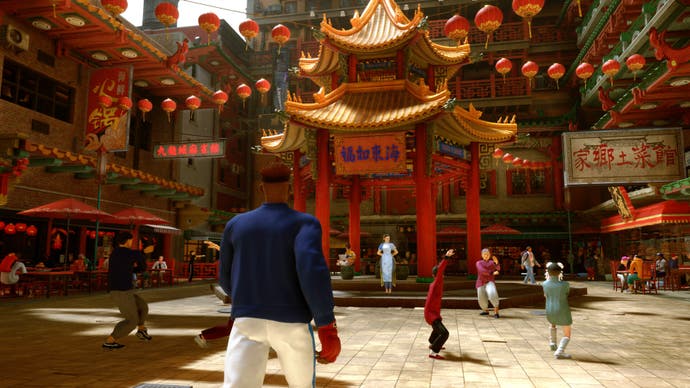
You'll meet famous Street Fighter characters in self-contained areas lifted from their stages. Ryu, for example, can be found sat meditating in an idyllic slice of the Japanese countryside that wouldn't look out of place on a postcard. Cammy is of course standing with a serious look on her face outside a London pub. Big Ben is in the background and there's a red bus. Dhalsim is in India, flanked by elephants. The stretchy sage always has something wise to say, and enjoys spice as a gift. You can visit a master to learn more of their special moves, or just have a chat. World Tour is as close to a Street Fighter relationship sim as we've ever seen. It's hilarious and kind of great.
The thing to say about World Tour is that while I don't think fighting game combo fiends need or necessarily want a near 30-hour Street Fighter campaign, I am delighted it exists. It's janky (the platforming is awful), the story is nonsense and the fighting itself gets boring after a while. But it's overwhelmingly endearing. My enduring memory of World Tour is the time I got a text message from Ryu. Seemingly using a mobile phone for the first time, this most stoic of world warriors, he who has shunned all material things, signs his name at the end of each of his texts. Of course he does - it's old out of touch uncle Ryu! You have a couple of options in response: tell Ryu he's doing texting all wrong, or tell him he's doing just fine and he should keep at it. Welcome to Street Fighter 6 - a fighting game in which I wear a giant bao bun on my head and get heart-warming DMs from Ryu.
World Tour is a crucial part the bigger picture: Street Fighter 6 is a fighting game not just for fighting game fans, but for pretty much everyone. There will be some who will never play Street Fighter - or any fighting game - in a competitive setting, either online or local. This bizarre single-player sojourn is for them. Unashamedly, joyously for them.
Perhaps that can also be said of the new modern control system, which is the most significant change to the act of pressing buttons and making things happen in Street Fighter in years. This control scheme lets you perform context-dependent combos and special moves without the need for complex input commands. Using this control scheme, you can press one or two buttons plus a single direction and combos you'd normally need a high-level ability to execute just happen. We're talking about auto dash cancelling, air juggles and Critical Arts, that sort of thing.

My view is Street Fighter 6's modern control scheme will be liberating for a huge number of people who would otherwise struggle not just to compete online, but simply play the game. It'll help people get through World Tour, which is difficult towards the end. It'll help newcomers with arcade mode. And yes, it'll help when playing against other people.
The game displays which control scheme is being used by which player at the top of the screen, and it does not segregate between modern and classic when it comes to matchmaking. Some purists will look down their noses at modern control players, but this is the right decision from Capcom. Street Fighter 6 is a game for everyone and splitting the player base down the middle would do more harm than good.
In any case, the modern control scheme does not help players out with the fundamentals. Things like spacing, anticipation and mind games are not beholden to the press of a button, but a thought of the mind. I've played plenty of players who used modern controls and yes, occasionally I ate an elaborate combo I knew was the result of a few simple button presses, but on the whole I emerged victorious. There is no control scheme that prevents a newcomer from repeatedly jumping in or leaving themself open to a punish. Street Fighter 6 - and it should be said the fighting game genre as a whole - is brutally difficult. It is inaccessible for most who play games let alone those who do not. Street Fighter 6's modern control scheme does not break the rules of the game - Guile's Sonic Boom is still limited by the time it must take to charge - it just makes those rules accessible, and for that I am thankful.
And it's not like doing all this stuff detracts somehow from the bits of Street Fighter 6 that fighting game fans are most interested in. In fact, quite the opposite. Street Fighter 6 is a wonderful fighting game and refreshingly different in feel to the ultra aggressive Street Fighter 5. Rounds feel longer and zoning (keeping your opponent away with, for example, a projectile-heavy strategy) is back. Street Fighter 6 feels heavier on anticipation than raw, in your face pressure (newcomer Kimberly is perhaps the exception here). It's a game in which well-executed plans and successful adaptation are as satisfying as smashing your opponent into submission with a multi-hit corner combo.
The new Drive Gauge is central to Street Fighter 6's fresh style. This resource governs a number of powerful abilities, including the Drive Impact. Oh boy has Drive Impact caused a kerfuffle among Street Fighter fans! This is a move that can only evoke one of two emotions: delight or despair. Anticipate an attack from your opponent, chuck out a Drive Impact and you'll absorb the attack before smacking them in the face, leaving your helpless victim open to a follow-up. Drive Impact is so good it initially feels overpowered.

The clever bit is how the Drive Gauge is balanced. Overuse it and it'll drain completely, leaving you in an underpowered "burnout" state that prevents you from using Drive Impact, parrying or even Overdrive Arts (EX special moves of old). Better, though, is Drive Impact has a natural counter: itself. If you anticipate or react to your opponent's use of Drive Impact, you can throw it out yourself for a dramatic slow motion coming together of blows. You'll absorb your opponent's Drive Impact attack, land a hit and create an opportunity for a high damage follow-up. There are fun mind games to be had baiting a Drive Impact out of your opponent, even when you're backed into a corner.
I could go deeper into the other abilities the Drive Gauge governs, such as parrying (perfect parry for the win!) and Drive Rush (dashing for the win!) and the other clever ways Capcom has balanced its use, such as having Overdrive Arts consume two Drive Gauge stocks instead of super meter, but aficionados will find better breakdowns on the many Street Fighter guide pages across the internet. I will say this: fighting games are never truly understood until years after their release, but even at launch it feels safe to say a Street Fighter 6 player who wisely manages their Drive Gauge is one who has a good chance of winning. See? Ryu's rubbed off on me. Must be all those texts.
With each new Street Fighter game comes new characters and redesigns for old favourites. Most of Street Fighter 6's new characters inject young blood into the roster (we've finally moved past Street Fighter 3 timeline wise, so characters look a little older than they do in previous games). Kimberly, a music-loving graffiti artist slash ninja who trained under Final Fight's Guy is an early favourite and hate figure, depending on whether you're playing as her or against her, for her relentless corner pressure. Jamie, a breakdancing drunken master, isn't far behind. Grapple wise, Marisa is a giant, Lion-hugging Italian jewellery designer and MMA-Pankration fighter who wouldn't be out of place alongside King Lionidas and the 300. Manon combines ballerina with judo (why not?). Lily, the next-gen T. Hawk, is perhaps my least favourite new character because she doesn't seem to have as many options as the other characters. JP, Street Fighter's new big bad, is a complex keep-away specialist who finally answers the question no-one asked: what if Gandalf had become an investment banker?
Most of the returning characters look and feel as you'd expect. Ryu has a few new tricks but he's essentially the same all-rounder with the added benefit of being in a game that likes zoning. I picked up and played my main man Guile without dropping a beat. Zangief still struggles to get in for a Spinning Piledriver. I'm glad E. Honda is back but he feels pretty useless. He's got a great vibe though!
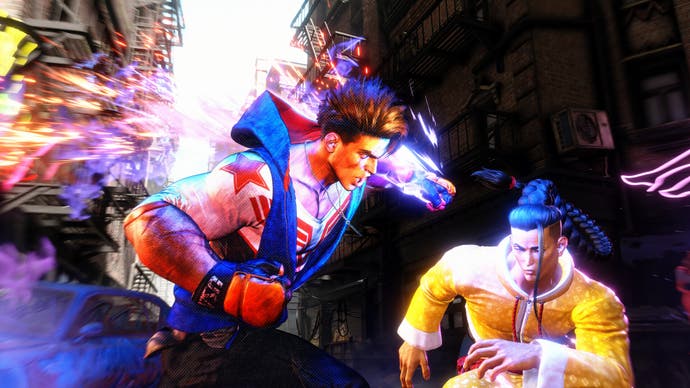
Vibrant, inventive design and superb animation course through all. Jamie's drunken master moves are silky smooth and worthy of a Jackie Chan flick. Cammy's redesign - already a fan favourite for obvious reasons - is a triumph. The art style remains heavily stylised (look at Luke's forearms!) and impressively detailed. Look beyond the muscle definition and you'll see beautiful outfits and stages packed with objects and people in motion. Ryu's Japan stage, for example, is drenched with pink petals that puff up as you move about. Manon's travelling circus is a beautiful fusion of light and dark set against a Paris backdrop complete with looming Eiffel Tower. Street Fighter 6, like its predecessors, looks and feels world class. I expect nothing less.
It's a good thing, too, because Capcom desperately wants players to shout about Street Fighter 6 from the rooftops. This is the most social Street Fighter game I've played. The outrageous character customisation seems destined for virality (watch out for nightmarish creations dancing in the Battle Hub). World Tour has a photo mode boosted by a relationship system that makes the likelihood a master will pose for a selfie increase the more you get on. Yep, you can give Zangief and co gifts to help - although I've yet to work out what the Russian wrestler truly appreciates (fighting mags don't help with working out in the gym, apparently).
The Battle Hub deserves particular praise. You can ignore it completely by jumping straight into ranking or casual matchmaking, or you can have your character explore a sci-fi arcade, something reminiscent of Sony's now-dead PlayStation Home. Here you can buy new clothes for your avatar, play emulated retro Capcom games and even fight with your created character in carefree bouts. But the best bit is the ability to sit down at a virtual cab and challenge someone to a match. On one occasion I ended up in an epic set of matches against an opponent who was at least as good as I was. After a close first to 10 set we both got up from our virtual seats and cheered each other with emotes. A handful of other players had spectated our match, their avatars huddled around the cab. "GG," I wrote in the hub chat, for all in the lobby to see. "GG," was the response. I was transported to Megabowl in Streatham and a childhood spent training against real humans in the real world. Those days, like the arcade scene itself, are sadly over, but I am thankful Street Fighter 6 has rekindled a bit of that magic for me all these years later.
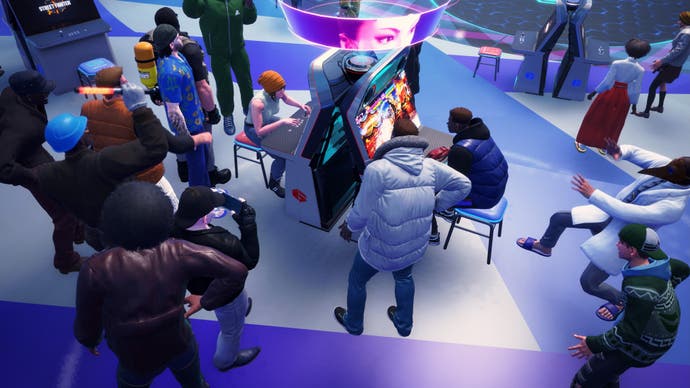
At this stage I have mild concerns, rather than criticisms. The user interface is abstruse, making it hard to work out how to do even simple things like change your control scheme for all characters. Navigation often feels like a fight in itself. You do get there, eventually, but you may need to look to the internet for help on occasion.
And while it's hard to predict a live service game's post-launch monetisation, we do know Street Fighter 6 will have a paid battle pass as well as a premium currency. We also know its first wave of DLC characters. It'll be interesting to see how much Capcom charges for all these micro-transactions, and how fans react.
But at launch, Street Fighter 6 is as good a Street Fighter game as I could hope for. I've already put about 50 hours into it, and I can see it lasting me years. With the story done and dusted I am now free to grind in ranked, sweating through match after match after match until... damn, where did the time go? This is a Street Fighter with more than a modern control scheme - it is a modern take on the genre. It is welcoming, accessible and progressive. It is social, silly and spectacular. And it is very special indeed.
